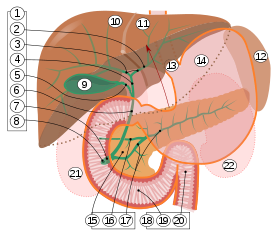Accessory pancreatic duct
Appearance
| Accessory pancreatic duct | |
|---|---|
 The pancreatic duct. | |
| Details | |
| Identifiers | |
| Latin | ductus pancreaticus accessorius |
| TA98 | A05.9.01.017 |
| TA2 | 3131 |
| FMA | 14534 |
| Anatomical terminology | |

2. Intrahepatic bile ducts
3. Left and right hepatic ducts
4. Common hepatic duct
5. Cystic duct
6. Common bile duct
7. Ampulla of Vater
8. Major duodenal papilla
9. Gallbladder
10–11. Right and left lobes of liver
12. Spleen
13. Esophagus
14. Stomach
15. Pancreas:
16. Accessory pancreatic duct
17. Pancreatic duct
18. Small intestine:
19. Duodenum
20. Jejunum
21–22. Right and left kidneys
The front border of the liver has been lifted up (brown arrow).[1]
Most people have just one pancreatic duct. However, some have an additional accessory pancreatic duct also called the Duct of Santorini, which is dorsal and usually (in 70%) drains into to the duodenum via the minor duodenal papilla. In the other 30% it drains into the main pancreatic duct, which drains into the duodenum via the major duodenal papilla. The main pancreatic duct and the accessory duct both eventually - either directly or indirectly - connect to the second part ('D2', the vertical segment) of the duodenum.
The Duct of Santorini is commonly non-functional, whereas the Duct of Wirsung is always functional when present. The two may not be connected.
It is named for Giovanni Domenico Santorini.[2][3]
References
- ^ Standring S, Borley NR, eds. (2008). Gray's anatomy : the anatomical basis of clinical practice. Brown JL, Moore LA (40th ed.). London: Churchill Livingstone. pp. 1163, 1177, 1185–6. ISBN 978-0-8089-2371-8.
- ^ synd/3087 at Who Named It?
- ^ G. D. Santorini. Observationes anatomicae. Venetiis, apus J. B. Recurti, 1724
External links
- pancreas at The Anatomy Lesson by Wesley Norman (Georgetown University) (pancreasduct)
